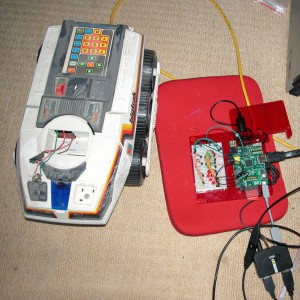Some years ago, I bought a Big Trak off ebay with a view to making it work – although it was sold as “working”, the seller was slightly creative with the truth, but since the price was right (a fiver) I wasn’t going to complain too much…
My thoughts at the time were to put an Arduino inside it to take over control – that never happened…
So fast forward a few years and we now have the Raspberry Pi and as I’ve been doing a lot of work with it’s on-board GPIO, I thought it would make an idea project for the Pi, so these pages are going to document my efforts to make my old Big Trak toy tank work with a Raspberry Pi.
If you’re not familiar with the Big Trak, it’s a programmable 6 wheeled tank-like toy that was popular in the early 1980’s. It featured a keyboard for data entry, a “Photon Canon” (a bulb and a blue filter), and a speaker for making various noises with. Using the keypad you could program up to 16 steps in it – which included moving forwards, backwards or turning (using minutes on a clock face as the angle).
The above image from the Wikipedia Article
Primary aims:
- Replace Control board with Raspberry Pi.
- Keep original keyboard – if possible.
- Upgrade the battery pack (rechargable, higher capacity)
- Add on an LCD display.
Additional desires:
- Some sort of remote control (URF Radio probably)
- Sensors to detect objects.
- Autonomous actions.
Watch this space, as they say…
Quick update to this: 21st August 2012:
It turns out this Big Trak I bought off eBay a few years ago has been somewhat tampered with – it’s been taken apart by someone else and sadly not put together in too sympathetic manner – with some critical bits missing – the mechanicals for the wheel drive being the main bits missing, so until I can source another, or make some repairs, this is on-hold, however… Do check the blog for a Plan B – Pi Lego Trak!



Oo oo!!! I’m looking forward to this. I used to have one as a child. 🙂
Slowly putting together plans – the first thing was to take it to bits (of-course) and it’s now sitting in a pile of 100 bits or so…
However, it’s going to be relatively straight forwards – the hardest thing to crack so-far has been power, but a chance chat and I’ve no discovered the magic of the “18650” battery which I think will save the day..
-Gordon
How about one from Maplin? Juast saw it today. http://www.maplin.co.uk/bigtrak-junior-540853… I am going to buy one tomorrow
I think that’s a small version – hence the “Junior” title. Do check before you buy!
-Gordon
bought one from tesco.com last week £25.60 dilivered to nearest store click and collect
I got one from Firebox a while ago….pretty sure I Want One Of Those has them as well. Definitely full size, around £30.
Somewhere (!?) I have a complete gearbox set with motors etc. It was dead from a ‘boot sale. Opened it up and was amazed by the magnetic link to get it to go straight. I ditched the battered body but kept the guts. If (IF) i can find it, the gearbox etc is yours if you want it.
Mark
I was recently sent a new one, thanks! Yes, the old one with the magnetic coupling – pretty good. Also pretty bad the way they wired the batteries up – 2 batteries would go flat before the other 2…
The new ones have 2 rotation sensors and no magnetic coupling…
-Gordon
Man You are great and your lib are great :). I build my own car in 2 days http://www.youtube.com/watch?v=Ay33BFERYOw
Looks good!
-Gordon
With your WiringPI at the heart , along with a few other things such as infra-red, wii control and a robot arm.
http://www.youtube.com/channel/UC923u8DIqeUYQc1WMHPNwhw
Fantastic!
-Gordon
Hi gordon, I have a implementation of sockets with TCP/IP and your library to control GPIO over an intertet conection (WiFi/Ethernet) in the raspberry pi part, the GUI control resides in PC (Written in Java), the GUI recieves stream video (MJPEG-Streamer) but can be used without this, do you have interest in him?
wiringPi v3 has a remote Pi module via tcp or udp, bu that won’t be ready for a while yet. However others might be interested in the video stuff – put it on github ?
-Gordon
I am trying to build a robot which (in fantasy land) would help to clear mines in places like Cambodia. The requirement I think is for a very cheap, light, easy to program (hence the pi is ideal) controller which would drive a small (about 50cm * 50cm * 50cm) vehicle carrying video cameras, metal detector, possibly ground penetrating radar (though this would be too expensive I expect) and any other detection equipment which could be practically carried. Using gps or short range radio and known antenna locations the pi could keep the vehicle driving along a “safe” boundary scanning the unsafe area on the unsafe side of the boundary. Any suspicious things could be marked, photographed and have its co-ordinates recorded. I think that the huge number of cheap mobile cameras, old stepper motors from disk drives, wifi components from dead laptops ( I’ve got two) could mean that the machines could be built cheap enough to make them almost expendable ( certainly massively cheaper that industrial versions ).
I have made my pi work well with stepper motors but I think the power required to drive the thing would be too much over rural terrain. I have several relays/motors/wheels etc which I am cobbling together to get some idea if this idea is at all feasible – anyone have any comments.
Z
I’m a Mechatronicist (Science, Engineering etc)and I’ve had a similar idea. IN my expert opinion it would be easy to have the required power. Things like mobile phone batteries can be supplemented by something like a solar panel as it would mainly be used in foreign countries where the sun shines strongly for most of the day. One thing I do have to say is though that you need to rethink about it’s components. Something like an x-ray scanner would work better, for example a metal detector would go mad at everything from old bottle caps to bullet casings…
Have you made any progress with your Big Trak. I bought one, intending to follow the ideas of Skutter in MagPi, but that does not appear to be a complete implementation.
Not yet. One more thing I had to drop last year due to some family issues. Maybe next year!